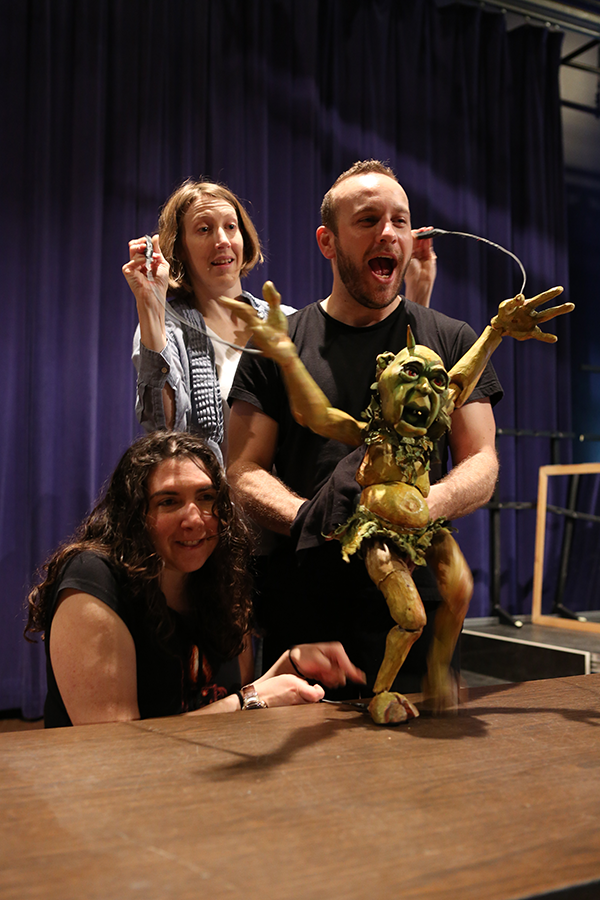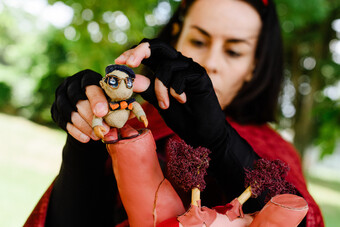When the Puppets Come to Town
The O’Neill series celebrates and investigates the Eugene O’Neill Theater Center’s fifty year impact on individual artists and the wider theatrical community.
Some say that puppetry is a dying art. Well I rebuke that. And every day, around the globe, at schools, festivals and conferences, on the street, in your theaters, on your televisions and more, puppet artists of all shapes and sizes do the same through their actions. They tell stories through the art of puppetry. Our chosen art form has been around since the dawn of time and it isn’t going anywhere, and I’ll prove it.
Puppets are sexy. They are fun. They are provocative. Some are beautiful. Others, grotesque. But most importantly, they allow audiences an opportunity to escape into a world otherwise unknown. They allow stories that may otherwise remain untold, to be shared, as puppets can do things that humans cannot. These are the facts.
In a country with relatively little support for the arts, choosing to live a life in theater already seems crazy to most. And puppets, well, you must not like to eat. Right? Wrong. If you want to make a livelihood at something, you train. You ask questions. You find people who complement your deficits, and you collaborate with them. You find a way to grow in your art form so that your strength can shine. This is hard for many puppeteers as they feel that they must be able to do it all themselves. This is just one reason why every June, in Waterford, Connecticut, “the puppets” come to town. Since the O’Neill’s founding, even before the National Puppetry Conference began twenty-four years ago, puppeteers have “found their tribe” in Waterford.
Puppeteers are a small and often lively group of storytellers. Some work alone while others work with troupes. More often than not though, they “work in a bubble.” In this country in particular, few have the privilege of “studying” the puppet arts at schools or universities. Some have been raised in puppeteering families, while others have apprenticed from a young age, and some have found their way to the form through other mediums, but many work alone and have yet to “find their tribe,” as artistic director of the National Puppetry Conference Pam Arciero says. For a select few, this is where the O’Neill bridges the gap. For more years than not, at the O’Neill, not only did puppet artists find their tribe, they find out that they have one! Now that’s pretty exciting.
That said, the tide has been changing in recent years. Who can tell if this is due to increased advertising and outreach, an increased number of places to learn the foundations of puppetry or the advent of the Internet? In addition to those seeking community, knowledgeable, highly skilled, working puppeteers are now looking to the O’Neill to help them advance their existing skill set and their vehicles for storytelling. And so, we do. The O’Neill itself is an institution focused on storytelling and we are blessed with the ability to focus on an artist’s work while it’s still in development. The institution’s motto is “Risk, Fail, Risk Again” for goodness sake. Puppeteers at all levels, novice to advanced, are able to grow within themselves while focusing on strengthening their work. And, as word has spread about the magic of the O’Neill, the mystique of the O’Neill in puppetry circles has died down, and our family has grown. To this I say, “hell yeah.”
You see, the great thing about a growing family isn’t just that you can go anywhere in the world and visit with some of your people, but that they earnestly want to support you and are rooting for you while you struggle to put up the best work you possibly can. Please don’t mistake this comment to mean that the O’Neill simply fosters a group of puppetry cheerleaders. It does not. However, if you are mounting a show in Australia and a former O’Neilly asks you a tough question about the material, don’t be surprised. There’s always room to grow. And with any luck, a fellow alumnus or alumna knows that this question is just as good a hug. Which among “the puppets” is likely to follow.
Breaking this down a bit more, once they have completed the application process and have been admitted, puppeteers from all over the country and the globe descend on the O’Neill each June to work on their craft. Individual focus may differentiate between manipulation techniques, story structure, character development, or something entirely different. But the goal remains the same: growth as an artist and quality storyteller. The puppeteers go back out into the world to explore what they have learned further and ultimately a version of what they explored is brought to stage. Where you ask? National Puppetry Conference alumni can be found on stages on the Great White Way, Off Broadway, and regional theaters across the country. They can be found touring the globe with large-scale productions, or a small touring show with great impact that is performed right out of their suitcase. They are relief workers, teachers, and entertainers. Some build the puppets, others write for them. Some direct them while others score their every movement. Some do it all. But what we all have in common, and what we share with all O’Neill alumni, is that no matter where in the world we are, no matter what roles we’re playing in a production, the lessons learned at the O’Neill are alive in our hearts and minds and the magic lives on.
So, please, if you’re feeling a joke come on… well, back off with your negative comments about puppetry. Try not to mock us too much. Sure, we often use what appears to you to be dolls to get our point across. But you’re in good hands. We’re professionals and we love what we do. Please enjoy the gifts that we are offering. Our stories. Good, smart, well-crafted stories… told with puppets! Oh, and by the way, we’re not going anywhere.
***
All photos by Richard Termine










Comments
The article is just the start of the conversation—we want to know what you think about this subject, too! HowlRound is a space for knowledge-sharing, and we welcome spirited, thoughtful, and on-topic dialogue. Find our full comments policy here
To Jean Marie's excellent -- and accurate -- piece, I will add that it's too bad Disney got his hands on The Magic Kingdom before the National Puppetry Conference had a chance at it, 'cause it truly applies.
(So does "imagineering," but I don't want to appear greedy...)